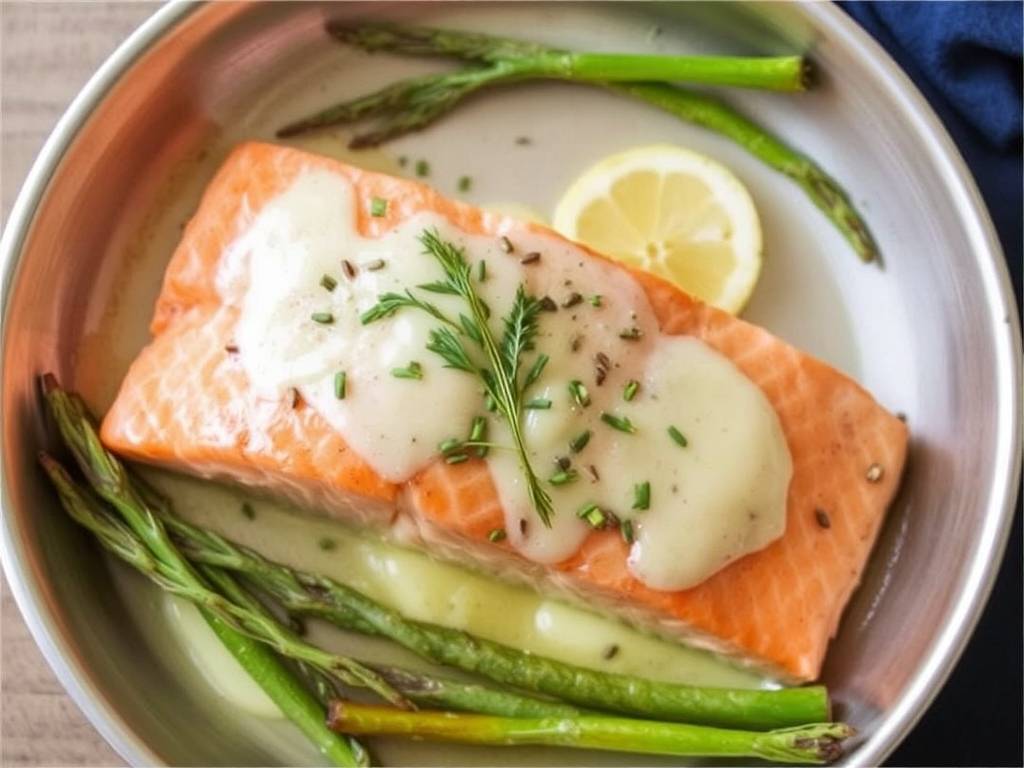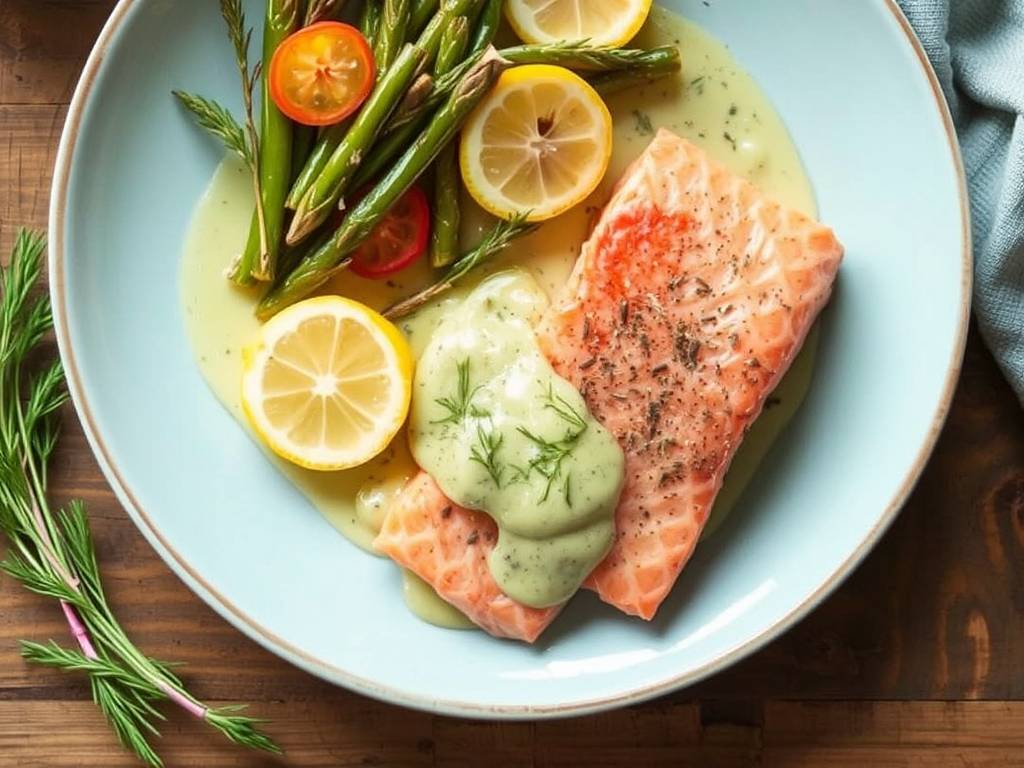Mastering the Art of Pan-Seared Salmon with a Luscious Lemon and Dill Butter Sauce
Salmon, with its rich, flavorful flesh and impressive nutritional profile, stands as a crown jewel in the world of seafood. While its versatility allows for countless preparations, few methods highlight its natural elegance as perfectly as a simple pan-sear, finished with a vibrant, classic sauce. The combination of lemon and dill butter sauce is a timeless pairing that elevates the fish without overpowering it, creating a dish that is simultaneously sophisticated and surprisingly simple to master. This guide will walk you through every step, from selecting the perfect fillet to emulsifying a restaurant-quality sauce, ensuring you can create this culinary masterpiece with confidence.
The Foundation: Selecting and Preparing Your Salmon

The journey to an exceptional dish begins with quality ingredients. For salmon, this is paramount.
- Choosing the Cut: You have two primary options: skin-on or skin-off fillets. For pan-searing, a skin-on fillet is highly recommended. The skin acts as a natural barrier, protecting the delicate flesh from the direct heat of the pan. As it cooks, the skin renders its fat, basting the salmon from below and becoming irresistibly crispy, adding a wonderful textural contrast. Look for center-cut fillets, which are of uniform thickness, ensuring even cooking.
- Variety Matters: Atlantic, Sockeye, Coho, and King (Chinook) salmon are common varieties. Atlantic salmon is often farm-raised, yielding a fattier, milder-tasting fillet that is very forgiving to cook. Wild-caught varieties like Sockeye are leaner, with a deeper, more robust flavor. Any will work beautifully in this recipe; choose based on your preference and availability.
- Preparation is Key: About 30 minutes before cooking, remove the salmon from the refrigerator. Allowing it to come to room temperature is a critical step often overlooked. A cold fillet placed in a hot pan will cause a drastic temperature drop, leading to uneven cooking—a overcooked exterior and an undercooked center. Pat the fillets completely dry with paper towels. Moisture is the enemy of a good sear; it creates steam, which prevents the skin from crisping up. Season both sides generously with kosher salt and freshly ground black pepper.
The Aromatics and Sauce Components
The sauce, though simple, relies on the harmony of a few key ingredients.
- Freshness is Non-Negotiable: For the lemon and dill butter sauce, fresh herbs and freshly squeezed lemon juice are essential. Dried dill lacks the bright, grassy punch of its fresh counterpart, and bottled lemon juice carries a flat, sometimes bitter, taste. You will need:
- Unsalted Butter: Using unsalted butter allows you to control the seasoning of the dish precisely. You'll need about 4-6 tablespoons, cut into small cubes and kept cold.
- Fresh Dill: This herb offers a sweet, slightly anise-like flavor that pairs exquisitely with fish. Chop it finely just before using to preserve its volatile oils.
- Lemon: You'll use both the zest and the juice. The zest contains potent citrus oils that provide an intense aroma, while the juice offers the necessary acidity to cut through the richness of the butter and salmon.
- Aromatics: One small shallot, minced, and a clove of garlic, minced, will form the aromatic base of the sauce.
- White Wine (Optional but Recommended): A splash of dry white wine, such as Sauvignon Blanc or Pinot Grigio, deglazes the pan, lifting the flavorful browned bits (the fond) left by the salmon. This forms the foundation of your sauce, adding a layer of complexity. If you prefer not to use wine, you can substitute with a low-sodium chicken or vegetable broth.
The Cooking Process: A Symphony of Heat and Timing
This is where precision pays off. Have all your sauce ingredients measured and within arm's reach (mise en place), as the steps move quickly once the salmon is cooked.
- The Perfect Sear: Place a heavy-bottomed skillet (stainless steel or cast-iron are ideal) over medium-high heat. Let it get properly hot before adding any fat. Add a tablespoon of a neutral, high-smoke-point oil like avocado or grapeseed oil. Carefully place the salmon fillets in the pan, skin-side down. You should hear an immediate sizzle. Press down gently on the fillets with a spatula for the first 10 seconds to ensure the entire skin surface makes contact with the pan. This prevents curling and promotes even crisping.
- Patience with the Skin: Resist the urge to move or flip the salmon prematurely. Let it cook undisturbed for about 90% of the total cooking time. For a standard 1-inch thick fillet, this is approximately 5-6 minutes. You will see the color of the salmon change from a deep coral to a lighter pink, creeping up the sides of the fillet. The goal is to cook the salmon about three-quarters of the way through from the skin side.
- The Flip and Finish: Once the sides are cooked most of the way up, gently flip the fillets to cook the top side for just 60-90 seconds. This brief kiss of heat is enough to finish the cooking without drying out the fish. The internal temperature, when measured at the thickest part, should register between 125°F (52°C) for medium-rare and 135°F (57°C) for medium. Remember, the salmon will continue to cook slightly after being removed from the pan (carryover cooking). Transfer the cooked salmon to a warm plate and tent loosely with foil.
Crafting the Lemon and Dill Butter Sauce
With the salmon resting, it's time to create the sauce in the same pan, capturing all the delicious residual flavors.

- Deglaze: Reduce the heat to medium. If there is excess oil from the salmon, you can pour off all but a teaspoon. Add the minced shallot to the pan and sauté for 1-2 minutes until softened and fragrant. Add the garlic and cook for another 30 seconds, being careful not to burn it. If using wine, pour it into the pan. It will sizzle and steam dramatically. Use a wooden spoon or whisk to scrape up all the browned bits from the bottom of the pan. Let the wine reduce by half, which should take about a minute.
- The Lemon Base: If you are not using wine, add the lemon juice directly at this stage along with the shallots and garlic. Let it simmer and reduce slightly for about a minute to concentrate the flavor.
- Mounting with Butter (Monter au Beurre): This is the classic French technique that gives the sauce its velvety body. Reduce the heat to low. Begin whisking in the cold, cubed butter one or two pieces at a time. Wait for each addition to melt and incorporate into the sauce before adding the next. Whisking constantly is crucial; it encourages the butterfat and water to emulsify, creating a smooth, cohesive sauce rather than a broken, greasy puddle. The sauce will gradually thicken and become glossy.
- Finishing Touches: Once all the butter has been incorporated, remove the pan from the heat. Stir in the fresh dill and lemon zest. Taste the sauce and season with a pinch of salt and pepper as needed. The sharp, acidic kick of the lemon will be beautifully balanced by the rich, creamy butter and the fresh, herbal notes of the dill.
Plating and Presentation
Spoon the warm lemon and dill butter sauce directly onto warmed plates. Place the crispy-skinned salmon fillet atop the sauce. The visual appeal is part of the experience—the golden-brown skin, the vibrant pink flesh, and the specks of green dill in the pale yellow sauce. For a final touch, you can garnish with an extra sprig of dill and a thin slice of lemon.
Serving Suggestions
This dish is wonderfully versatile. For a light, elegant meal, serve it with:
- Simple Steamed Asparagus or Green Beans: Their crisp-tender texture and mild flavor complement the salmon without competing.
- Garlic Mashed Potatoes or Creamy Polenta: These act as a perfect canvas to soak up the exquisite sauce.
- A Quinoa or Orzo Pilaf: A wholesome grain adds substance and makes the meal more filling.
- A Glass of Wine: A crisp, acidic white wine like Sauvignon Blanc or an unoaked Chardonnay will mirror the lemon notes in the sauce and cleanse the palate between bites.
Conclusion: A Dish of Confidence and Flavor
Pan-seared salmon with lemon and dill butter sauce is more than just a recipe; it is a lesson in fundamental cooking techniques. It teaches the importance of proper searing, the art of emulsification, and the power of balancing rich, acidic, and fresh flavors. By understanding the "why" behind each step, you equip yourself not just to replicate this dish, but to apply these principles to countless other culinary creations. So, approach your stove with confidence, embrace the sizzle, and prepare to impress with a dish that speaks volumes of your skill and taste.






发表评论